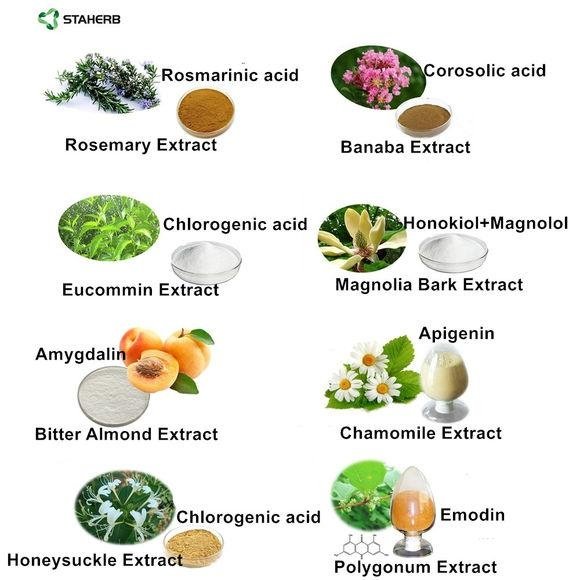98% Neu5Ac, N-Acetylsialic Acid, NANA, Sialic Acid
Product Name:Sialic acid
Other Name: N-Acetylneuraminic Acid, Neu5Ac, NANA Powder
CAS No.:131-48-6
Purity:98% min
Molecular Formular:309.2699
Appearance:Whiter powder
About Sialic aicd
Sialic acids refer to a family of neuraminic acids which contain nine-carbon acidic amino monosaccharides. It was originally isolated from the mucin of the submandibular gland, hence the name.The most important member of the sialic acid is N-acetylneuraminic acid (Neus Ac or NANA) occuring most abundantly in glycoproteins and glycolipids. Among all types of sialic acids, only N-acetylneuraminic acid can be found in human tissues Therefore, sialic acid, to human beings, refers to N-acetylneuraminic acid. The yield of SA through microbial fermentation production. After bacteria and liquor separation, ultrafiltration and concentration, impurity removing (protein, soluble salt), polysialic acid purification polysialic acid hydrolysis purification, both of polysialic acid and N-acetylneuraminic acid reached a purity of more than 99% after purification detected by HPLC.
Sialic acid main function:
1.Sialic acid for anti-virus function.
2.Sialic acid for anti-cancer function.
3.Sialic acid for anti-inflammation function.
4.Sialic acid for defensive function against bacteriological infectiong.
5.Sialic acid for controlling ability of immune system.
6.Sialic acid for restraining ability against pigmentation.
7.Sialic acid for signal transformation in nerve cells.
8.Sialic acid for play a key role in brain development and learning.
9.Sialic acid for as precursor for the manufacture of many pharmaceutical drugs.
Sialic acid application:
1.Sialic acid for anti-inflammation;
2.Sialic acid for enhancing human immunity;
3.Sialic acid is known as mental development of "brain gold";
4.Sialic acid used for cosmetics, food, health supplements;
5.Sialic acid adding infant milk powder can increase babys’ intelligence and memory;
Specification
|
ITEMS
|
STANDARD
|
RESULT
|
|
Appearance
|
White powder
|
Conform
|
|
Impurities
|
No visible impurities
|
Conform
|
|
Smell
|
Sweet and sour taste
|
Conform
|
|
Assay
|
>98.0%
|
98.60%
|
|
pH
|
1.8-2.3
|
2.11
|
|
Loss on Drying
|
<2.0%
|
1.50%
|
|
Transmittance
|
>98.0%
|
98.4%
|
|
Ignition Residue
|
<2.0%
|
0.12%
|
|
Aflatoxin B1
|
<5.0^g/kg
|
Not detected
|
|
Pb
|
<1.0ppm
|
Not detected
|
|
As
|
<1.0ppm
|
Not detected
|
|
Hg
|
<0.2ppm
|
Not detected
|
|
Total Plate Count
|
<1,000cfU/g
|
25cfu/g
|
|
Yeasts/Moulds
|
<100cfu/g
|
Not detected
|
|
Enterobacteriaceae
|
<60MPN/100g
|
Not detected
|
|
Staphylococcus Aureus
|
Not detected
|
Not detected
|
|
Salmonella
|
Not detected
|
Not detected
|
References:
-
1.
Aula N, Salomaki P, Timonen R, Verheijen F, Mancini G, Mansson JE, Aula P, Peltonen L (2000) The spectrum of SLC17A5-gene mutations resulting in free sialic acid-storage diseases indicates some genotype-phenotype correlation. Am J Hum Genet 67:832–840
-
2.
Aula P, Autio S, Raivio KO, Rapola J, Thoden CJ, Koskela SL, Yamashina I (1979) “Salla disease”: a new lysosomal storage disorder. Arch Neurol 36:88–94
-
3.
Aula P, Gahl WA (2001) Disorders of free sialic acid storage. In: Scriver CR, Beaudet AL, Sly WS, Valle D (eds) The Metabolic and Molecular Bases of Inherited Disease. New York, McGraw Hill, pp 5109–5120
-
4.
Cardo PP, Lombardo C, Gatti R (1985) A simple detection of sialic acid storage disorders by urinary ‘free’ and ‘total’ sialic acid determinations. Clin Chim Acta 150:129–135
-
5.
Denny PC, Denny PA, Allerton SE (1983) Determination of sialic acid using 2-thiobarbituric acid in the absence of hazardous sodium arsenite. Clin Chim Acta 131:333–336
-
6.
Froissart R, Cheillan D, Bouvier R, Tourret S, Bonnet V, Piraud M, Maire I (2005) Clinical, morphological, and molecular aspects of sialic acid storage disease manifesting in utero. J Med Genet 42:829–836
-
7.
Galjaard H (1980) Genetic Metabolic Diseases. Elsevier/North-Holland Biomedical, Amsterdam
-
8.
Grosso S, Berardi R, Farnetani MA, Margollicci M, Mancini MG, Morgese G, Balestri P (2001) Multiple neuroendocrine disorder in Salla disease. J Child Neurol 16:775–777
-
9.
Ito M, Ikeda K, Suzuki Y, Tanaka K, Saito M (2002) An improved fluorometric high-performance liquid chromatography method for sialic acid determination: an internal standard method and its application to sialic acid analysis of human apolipoprotein E. Anal Biochem 300:260–266
-
10.
Krasnewich DM, Tietze F, Krause W, Pretzlaff R, Wenger DA, Diwadkar V, Gahl WA (1993) Clinical and biochemical studies in an American child with sialuria. Biochem Med Metab Biol 49:90–96
-
11.
Mancini GM, Beerens CE, Aula PP, Verheijen FW (1991) Sialic acid storage diseases. A multiple lysosomal transport defect for acidic monosaccharides. J Clin Invest 87:1329–1335
-
12.
Mancini GM, Hu P, Verheijen FW, van Diggelen OP, Janse HC, Kleijer WJ, Beemer FA, Jennekens FG (1992) Salla disease variant in a Dutch patient. Potential value of polymorphonuclear leucocytes for heterozygote detection. Eur J Pediatr 151:590–595
-
13.
Powell LD, Hart GW (1986) Quantitation of picomole levels of N-acetyl- and N-glycolylneuraminic acids by a HPLC-adaptation of the thiobarbituric acid assay. Anal Biochem 157:179–185
-
14.
Roboz J, Suttajit M, Bekesi JG (1981) Elimination of 2-deoxyribose interference in the thiobarbituric acid determination of N-acetylneuraminic acid in tumor cells by pH-dependent extraction with cyclohexanone. Anal Biochem 110:380–388
-
15.
Seppala R, Lehto VP, Gahl WA (1999) Mutations in the human UDP-N-acetylglucosamine 2-epimerase gene define the disease sialuria and the allosteric site of the enzyme. Am J Hum Genet 64:1563–1569
-
16.
Sewell AC, Poets CF, Degen I, Stoss H, Pontz BF (1996) The spectrum of free neuraminic acid storage disease in childhood: clinical, morphological and biochemical observations in three non-Finnish patients. Am J Med Genet 63:203–208
-
17.
Schauer R (2000) Achievements and challenges of sialic acid research. Glycoconj J 17:485–499
-
18.
Traving C, Schauer R (1998) Structure, function and metabolism of sialic acids. Cell Mol Life Sci 54:1330–1349
-
19.
Valianpour F, Abeling NG, Duran M, Huijmans JG, Kulik W (2004) Quantification of free sialic acid in urine by HPLC-electrospray tandem mass spectrometry: a tool for the diagnosis of sialic acid storage disease. Clin Chem 50:403–409
-
20.
Verheijen FW, Verbeek E, Aula N, Beerens CE, Havelaar AC, Joosse M, Peltonen L, Aula P, Galjaard H, van der Spek PJ, Mancini GM (1999) A new gene, encoding an anion transporter, is mutated in sialic acid storage diseases. Nat Genet 23:462–465
-
21.
Verheijen FW, Mancini GM (2003) Lysosomal sialic acid transporter sialin (SLC17A5):sialic acid storage disease (SASD). In: Broer S, Wagner CA (eds) Membrane Transporter Diseases. Kluwer Academic/Plenum, New York, pp 233–239
-
22.
Warren L (1959) The thiobarbituric acid assay of sialic acids. J Biol Chem 234:1971–1975
-
23.
Waters PJ, Lewry E, Pennock CA (1992) Measurement of sialic acid in serum and urine: clinical applications and limitations. Ann Clin Biochem 29:625–637
-
Changsha Staherb Natural Ingredients Co.,ltd.
Address: Room.202, Buliding B8, Huanchuang Enterprise Square, High-tech Development Zone, Changsha, Hunan, China(410205)
Contact:Mary
Email: sales05@staherb.cn sales@staherb.cn
Tel :+86-(0)731-84213302 Fax:+86-(0)731-85953715
Website:www.staherb.cn
|
|




